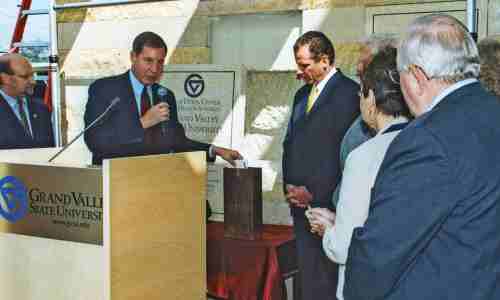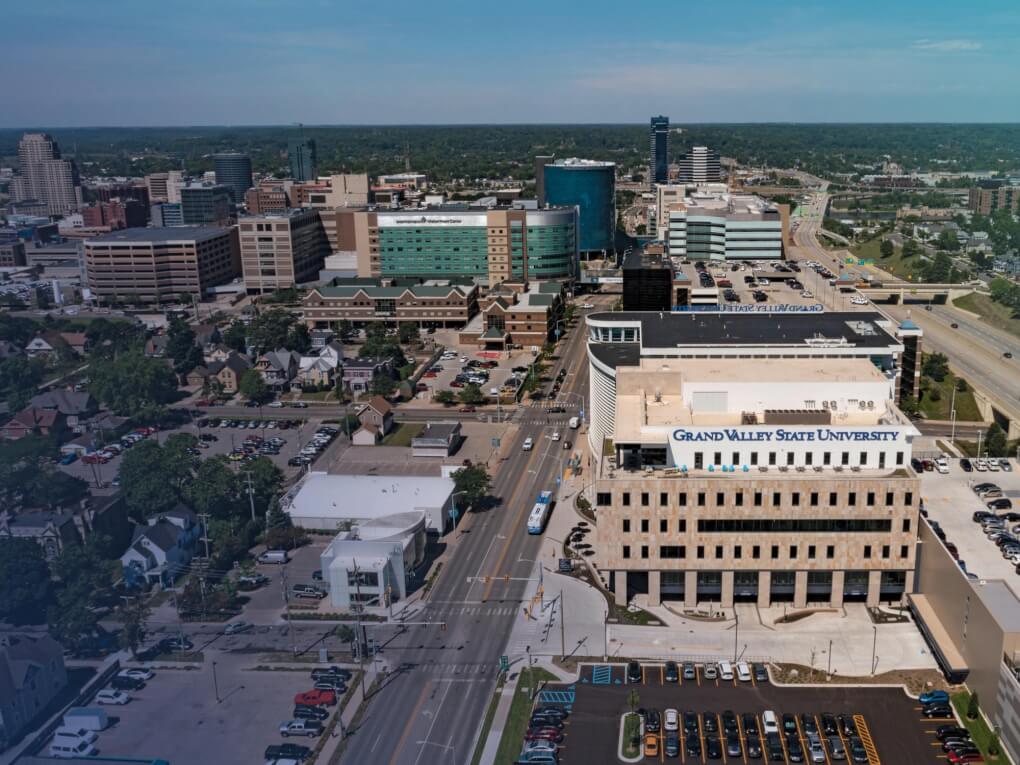In the 1990s, with Grand Valley’s health professions programs, particularly nursing, experiencing substantial growth, university leaders were scouting possible locations for expansion on the still young Pew Grand Rapids Campus.
Today, with the opening of the DeVos Center for Interprofessional Health (DCIH), Grand Valley’s three-building Health Campus, which also includes Raleigh J. Finkelstein Hall, anchors the east end of the Medical Mile. As the first educator with a presence on Medical Mile, Grand Valley has played a crucial role in Grand Rapids becoming a destination for health care, city and university leaders say.
Grand Valley has been “a really strong collaborator” in the Medical Mile pillars of higher education, health care systems and research, said Grand Rapids Mayor Rosalynn Bliss. From the community’s standpoint, GVSU’s contribution to the growth of the Medical Mile has wide-ranging effects, she said.
“The greatest influence is the impact that it has had on strengthening the local economy, as well as our regional economy,” Bliss said.
She noted that the strength of the Medical Mile’s influence has attracted major health-related companies to establish headquarters there. She also said Grand Valley meets the needs of companies seeking to locate here by providing a talent pipeline of students.

Former President Mark A. Murray, center, speaks during the dedication of the Cook-DeVos Center for Health Sciences in 2003. (University Communications)

Twenty years ago, Grand Valley University Foundation Chair Rich DeVos announced, “Health is the new frontier,” at the foundation’s annual meeting. In 2001, the foundation put a plan in motion to raise $21 million to support a health sciences center through its Building for Life campaign. Ground was broken in the spring for the Cook-DeVos Center for Health Sciences (CHS).
That announcement formalized a plan a decade in the making. Matt McLogan, vice president for University Relations, recalls one day gazing at a crane along the Michigan Street hill in use for construction at what is now Spectrum Health Butterworth.
McLogan said Arend D. Lubbers, president emeritus, encouraged him to meet with Butterworth officials, leading to the hospital selling Grand Valley the property at Michigan Street and Lafayette Avenue NE where CHS now stands. It was the start of many strong partnerships between GVSU and Medical Mile representatives.
Thomas J. Haas, president emeritus, said when he arrived in 2006 he quickly saw the opportunities for more expansively educating students.
He said what he called “bricks” were in place with Spectrum Health, the Van Andel Institute and the planned Michigan State University College of Human Medicine. He wanted to continue the strong Medical Mile partnership model by ensuring Grand Valley could expand on providing the “mortar” — nurses and the full array of health care professionals beyond physicians.
“We asked, ‘How can we create the pathway forward to ensure we deliver on that mortar?’” Haas said. “We wanted to provide the best array of programming to deliver on the promise as we saw it — Medical Mile being a preeminent center for health care. My vision was to have a three-building solution to create that mortar.”
With CHS in place, the next piece of that three-building vision meant an innovative approach and expanded partnerships with the City of Grand Rapids and the Belknap Lookout neighborhood just to the north, GVSU officials said. Grand Valley wanted to place a new health building in the neighborhood but officials also knew they needed to work cooperatively to help neighbors handle the disruption and relocation.
Extensive outreach by Pat Waring, former community relations director, and other university representatives led to a memo of understanding in 2016 that paved the way for Finkelstein Hall. The document stated the three parties (GVSU, City of Grand Rapids and Belknap neighbors) were committed to cooperatively developing the property while keeping the needs of the neighborhood and those who lived there at the forefront.
With the support from the State of Michigan, DeVos family and other donors, the final piece of the three-building solution came to fruition with the recently opened DCIH, Haas said.
Beyond those important local impacts, Haas said state lawmakers also took notice of Grand Valley’s expanding influence on health care in the region. That was important as GVSU sought and the state approved funding for new health buildings.
McLogan said lawmakers overseeing capital outlay have been receptive to Grand Valley because of the university’s lead role in addressing the changing dynamics of medical care.
“Legislators saw medical care changing from doctor and patient to doctor, team and patient,” McLogan said. “We are the producers of the team.”
Teresa Beck, acting dean for the College of Health Professions, has been integrally involved in the growth of the number of Lakers joining those medical teams for their careers. Beck, who joined GVSU in 1995 as a recreational therapy faculty member, was on planning teams for all three Health Campus buildings.
She remembered that the explosive growth of the health programs was evident even as CHS opened. “We moved in 2003, and we knew we had already outgrown the space,” Beck said.
The addition of the two most recent buildings on the Health Campus has provided needed laboratory and learning spaces where innovation is setting Grand Valley apart, Beck said. Meanwhile, having enough proper office space for educators — some of whom were once at rented off-campus locations — fosters meaningful interactions between faculty and students.
Beck said she believes Grand Valley’s longstanding presence on Medical Mile has benefited students, health care professionals who value opportunities such as adjunct positions, and academic programs receiving the West Michigan medical community’s expertise.
“It’s made us very visible because we are so centrally located to our health care partners, it has allowed for expanding our partnerships,” Beck said.
Reflecting on her time with Grand Valley watching the Health Campus grow, Beck is grateful for the deep community support and comprehensive facilities now in place.
“It has gone beyond my expectations,” Beck said.
Haas said the long-term vision for educating “a cadre of outstanding professionals here in West Michigan” has come to fruition during the tenure of President Philomena V. Mantella.
“All of this came together in a holistic way,” Haas said. “We will continue to see the impacts GVSU has for generations to come.”









